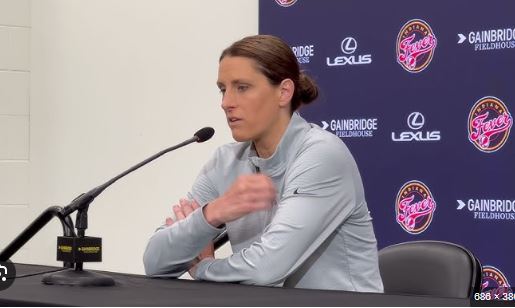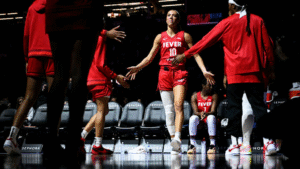
Indiana Fever Face More Injury Setbacks as Season Challenges Continue — How the Team Can Adjust and Keep Competing
The Indiana Fever’s ongoing battle with injuries took another major hit on Friday, creating an even steeper uphill climb for a roster that has already been tested repeatedly throughout the 2024 WNBA season. After a series of health-related setbacks in recent months, the team confirmed the devastating news: both veteran guard Sydney Colson and speedy playmaker Aari McDonald will be sidelined for the remainder of the year after suffering significant injuries in Thursday night’s contest against the Phoenix Mercury.

These injuries didn’t just remove two players from the lineup — they also stripped away vital experience, leadership, and depth at the guard position, an area where the Fever were already feeling the strain. What unfolded in Phoenix has left the team’s rotation thinner than ever, forcing head coach Stephanie White and her staff to rethink on-court strategies for the weeks ahead.
Details of the Injuries
The timeline of Thursday’s game makes the losses even more gut-wrenching. Sydney Colson — a respected veteran known for her defensive IQ, locker room presence, and ability to steady the offense — went down in the first quarter. She suffered a torn ACL in her left knee, an injury that not only ends her 2024 campaign but will also require a lengthy recovery process that could affect her preparation for next season. ACL tears often require months of rehab, meaning her road back will be long and demanding.
Later in the game, during the fourth quarter, Aari McDonald, who had been filling in as the starting point guard since July 15 in place of injured rookie star Caitlin Clark, sustained a broken bone in her right foot. McDonald’s quickness, defensive hustle, and energy have been key components in keeping Indiana’s offense organized and its perimeter defense aggressive. Losing her at this stage leaves a gap that will be difficult to fill, especially given her unique style of play and the chemistry she had been building with the Fever’s other core players.
A Season Full of Health Challenges
Injuries have been a constant theme for Indiana this year. The team has faced a revolving door of lineup changes, with various players missing stretches of games for different reasons. This instability has made it challenging for White to find and maintain a consistent rotation, develop long-term chemistry among starters, and give bench players clearly defined roles. Yet despite these constant disruptions, the Fever have managed to remain competitive, showing flashes of resilience and determination that have impressed both fans and analysts.
The latest example of that fight came on Saturday night, just two days after losing Colson and McDonald. Facing the Chicago Sky, Indiana took the court with only nine available players but still managed to secure an impressive victory. This win wasn’t just a matter of skill — it was a testament to the team’s mental toughness and ability to rally around each other in difficult circumstances.
Upcoming Matchups Offer Opportunity
Indiana’s next two scheduled games will be against opponents with losing records (sub-.500 teams), which offers a window for the Fever to keep their momentum and potentially climb in the standings. But these games will also test their ability to adapt quickly to yet another set of roster adjustments.
Recognizing the urgent need for backcourt help, the Fever announced on Sunday that they had signed veteran guard Odyssey Sims to a hardship contract. Sims, an experienced and versatile player, brings scoring ability, playmaking skills, and the capability to play both guard positions. Her presence should help stabilize the offense, provide leadership, and relieve some of the pressure from the starters.
The Caitlin Clark Situation
Meanwhile, fans continue to monitor the status of Caitlin Clark, the high-profile rookie whose injury has kept her sidelined. Officially, Clark remains listed as a game-time decision for Tuesday’s matchup. However, the team has offered no definitive return date, meaning her absence could stretch further into the season. Her eventual return will certainly have a major impact, but until then, the Fever must focus on finding workable solutions without her.
Stephanie White’s Coaching Challenge
The task now for head coach Stephanie White is as strategic as it is psychological: reorganize the roster in a way that maximizes the team’s strengths while masking its weaknesses, all while maintaining morale in the locker room.
For White, adversity isn’t unfamiliar. Throughout this season, she has navigated injuries, roster changes, and fluctuating performances. According to several players, these challenges have actually brought the group closer together. The constant need to adjust has fostered a sense of unity and mutual trust, with everyone understanding that success will require collective effort rather than individual heroics.
The Starting Five That Works
One of the biggest questions now is: what should the Fever’s starting lineup look like to give them the best chance to win?
With the lineup in flux for much of the season, it has been difficult to evaluate the team’s true potential. However, Saturday night’s rotation against Chicago — consisting of Sophie Cunningham, Lexie Hull, Kelsey Mitchell, Aliyah Boston, and Natasha Howard — showed promising balance. The unit demonstrated strong chemistry, with contributions from each player in both scoring and defensive responsibilities.
The Core Three: Mitchell, Boston, and Howard
The Fever’s “big three” this season has been Kelsey Mitchell, Aliyah Boston, and Natasha Howard. All three have delivered consistent high-level performances. Mitchell, a dynamic scorer with the ability to take over games, has adapted impressively to increased playmaking duties in light of the team’s guard shortages. Boston, a dominant presence in the paint, continues to anchor both ends of the floor with her rebounding, post scoring, and defensive timing. Howard, known for her versatility and veteran leadership, complements Boston inside while also stretching defenses with her midrange and occasional perimeter shooting.
Sophie Cunningham’s Emergence
For Sophie Cunningham, this season began with a setback — an ankle injury that limited her early production and rhythm. It took time for her to regain full confidence, but since Clark’s injury, Cunningham has emerged as a vital offensive threat. Over the past several games, she has consistently scored in double figures and is shooting better than 50% from three-point range, forcing opposing defenses to account for her on the perimeter.
Mitchell’s Historic Scoring Pace
Saturday’s win over Chicago further highlighted Mitchell’s remarkable season. She scored 26 points, pushing her season total to a league-leading 637. What makes this even more impressive is that she has done so while also serving as the team’s primary point guard, balancing scoring with distributing responsibilities.
Aliyah Boston and Natasha Howard’s Consistency
Boston’s play has been steady from opening night through the current stretch. She remains one of Indiana’s most reliable performers, dominating on the boards, protecting the rim, and serving as a go-to option in half-court sets. Howard has provided similar consistency, giving the Fever an inside-out scoring option and a defensive presence capable of guarding multiple positions.
Lexie Hull’s Shooting Struggles and Role Shift
Lexie Hull’s season has been something of a roller coaster. Earlier in the year, before Clark’s injury, she was a regular starter and appeared confident in that role. On July 17, she ranked fourth in the WNBA in field goal percentage at 46.8%, with her three-point shooting also among the league’s best.
However, after moving to a bench role, her shooting numbers dropped sharply. Her field goal percentage fell to 31.8%, with her three-point accuracy dipping by 25 percentage points. This decline coincided with a decrease in minutes and a reduced offensive rhythm.
Hull’s Strong Return to the Starting Lineup
The injuries to Colson and McDonald opened the door for Hull to rejoin the starting five against Chicago — and she responded in a big way. She posted a season-high 17 points, hit four three-pointers, and recorded three steals. Her energy on both ends of the court was noticeable, and the spacing she provided helped open lanes for her teammates.
The Importance of Hull Starting
Statistics support the case for Hull as a starter. In 11 games with her in the opening lineup, she has averaged 12.5 points per game, compared to 9.3 when coming off the bench. Her field goal percentage from two-point range is a strong 56.3% in those starts. These numbers indicate that Hull not only performs better personally when starting, but also helps improve the team’s offensive flow.
The Road Ahead
Given the current state of the roster, the Fever’s best bet may be to stick with the Chicago rotation as their starting five. This group offers a mix of shooting, defense, and inside presence. If Hull can maintain the confidence and rhythm she displayed on Saturday, she could help alleviate some of the offensive load carried by Mitchell, Boston, and Howard.
The rest of the paraphrase would continue expanding on:
- Odyssey Sims’ potential impact on chemistry and rotation.
- How White might stagger minutes to cover the guard shortage.
- Possible matchups in the next two games and why the sub-.500 opponents could be a turning point.
- Mental resilience themes — how adversity has shaped the Fever’s identity this season.
Leave a Reply